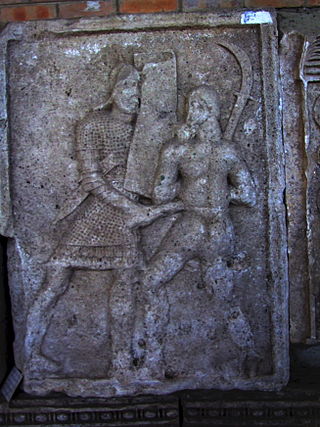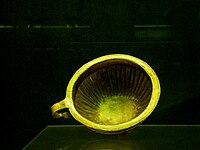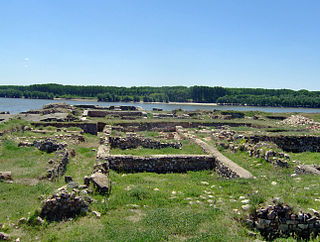
The Bastarnae, sometimes called the Peuci or Peucini, were an ancient people who between 200 BC and 300 AD inhabited areas north of the Roman frontier on the Lower Danube. The Bastarnae lived in the region between the Carpathian Mountains and the river Dnieper, to the north and east of ancient Dacia. The Peucini were a subtribe who occupied the region north of the Danube Delta. Their name was sometimes used for the Bastarnae as a whole.
Settlement in what is now Romania began in the Lower Paleolithic followed by written records attesting the kingdom of Dacia, its conquest, and subsequent Romanisation by the Roman Empire during late antiquity.

Dacia was the land inhabited by the Dacians, its core in Transylvania, stretching to the Danube in the south, the Black Sea in the east, and the Tisza in the west. The Carpathian Mountains were located in the middle of Dacia. It thus roughly corresponds to the present-day countries of Romania, as well as parts of Moldova, Bulgaria, Serbia, Hungary, Slovakia, and Ukraine.

The Dacians were the ancient Indo-European inhabitants of the cultural region of Dacia, located in the area near the Carpathian Mountains and west of the Black Sea. They are often considered a subgroup of the Thracians. This area includes mainly the present-day countries of Romania and Moldova, as well as parts of Ukraine, Eastern Serbia, Northern Bulgaria, Slovakia, Hungary and Southern Poland. The Dacians and the related Getae spoke the Dacian language, which has a debated relationship with the neighbouring Thracian language and may be a subgroup of it. Dacians were somewhat culturally influenced by the neighbouring Scythians and by the Celtic invaders of the 4th century BC.

The Thracians were an Indo-European speaking people who inhabited large parts of Southeast Europe in ancient history. Thracians resided mainly in Southeast Europe in modern-day Bulgaria, Romania and northern Greece, but also in north-western Anatolia in Turkey.

Dacian is an extinct language generally believed to be a member of the Indo-European language family that was spoken in the ancient region of Dacia.

The Agathyrsi were an ancient people belonging to the Scythian cultures who lived in the Transylvanian Plateau, in the region that later became Dacia. The Agathyrsi are largely known from Herodotus of Halicarnassus's description of them in the 5th century BC.

The Getae or Gets were a Thracian-related tribe that once inhabited the regions to either side of the Lower Danube, in what is today northern Bulgaria and southern Romania. Both the singular form Get and plural Getae may be derived from a Greek exonym: the area was the hinterland of Greek colonies on the Black Sea coast, bringing the Getae into contact with the ancient Greeks from an early date. Although it is believed that the Getae were related to their westward neighbours, the Dacians, several scholars, especially in the Romanian historiography, posit that the Getae and the Dacians were the same people.

The Dacian draco was a military standard used by troops of the ancient Dacian people, which can be seen in the hands of the soldiers of Decebalus in several scenes depicted on Trajan's Column in Rome, Italy. This wind instrument has the form of a dragon with open wolf-like jaws containing several metal tongues. The hollow dragon's head was mounted on a pole with a fabric tube affixed at the rear. In use, the draco was held up into the wind, or above the head of a horseman, where it filled with air and gave the impression it was alive while making a shrill sound as the wind passed through its strips of material. The Dacian draco likely influenced the development of the similar Roman draco.

The Thracian horseman is a recurring motif depicted in reliefs of the Hellenistic and Roman periods in the Balkans—mainly Thrace, Macedonia, Thessaly and Moesia—roughly from the 3rd century BC to the 3rd century AD. Inscriptions found in Romania identify the horseman as Heros and Eros and also Herron and Eron, apparently the word heros used as a proper name. He is sometimes addressed in inscriptions merely as κύριος, δεσπότης or ἥρως. Inscriptions from Bulgaria give the names Salenos and Pyrmerula/Pirmerula.

The prehistory of Southeastern Europe, defined roughly as the territory of the wider Southeast Europe covers the period from the Upper Paleolithic, beginning with the presence of Homo sapiens in the area some 44,000 years ago, until the appearance of the first written records in Classical Antiquity, in Greece. First Greek language is Linear A and follows Linear B, which is a syllabic script that was used for writing in Mycenaean Greek, the earliest attested form of the Greek language. The script predates the Greek alphabet by several centuries. The oldest Mycenaean writing dates to about 1400 BC. It is descended from the older Linear A, an undeciphered earlier script used for writing the Minoan language, as is the later Cypriot syllabary, which also recorded Greek. Linear B, found mainly in the palace archives at Knossos, Kydonia, Pylos, Thebes and Mycenae, disappeared with the fall of Mycenaean civilization during the Late Bronze Age collapse.

The Dacian bracelets are bracelets associated with the ancient people known as the Dacians, a distinct branch of the Thracians. These bracelets were used as ornaments, currency, high rank insignia and votive offerings Their ornamentations consist of many elaborate regionally distinct styles. Bracelets of various types were worn by Dacians, but the most characteristic piece of their jewelry was the large multi-spiral bracelets; engraved with palmettes towards the ends and terminating in the shape of an animal head, usually that of a snake.

The history of Dacian warfare spans from c. 10th century BC up to the 2nd century AD in the region defined by Ancient Greek and Latin historians as Dacia, populated by a collection of Thracian, Ionian, and Dorian tribes. It concerns the armed conflicts of the Dacian tribes and their kingdoms in the Balkans. Apart from conflicts between Dacians and neighboring nations and tribes, numerous wars were recorded among Dacians too.

The appearance of Celts in Western Romania can be traced to the later La Tène period . Excavation of the great La Tène necropolis at Apahida, Cluj County, by S. Kovacs at the turn of the 20th century revealed the first evidence of Celtic culture in Romania. The 3rd–2nd century BC site is remarkable for its cremation burials and chiefly wheel-made funeral vessels.

The Golden Helmet of Coțofenești is a Geto-Dacian helmet dating from the first half of the 4th century BC.

The Helmet of Iron Gates is a Geto-Dacian silver helmet dating from the 4th century BC, housed in the Detroit Institute of Arts, United States.
This section of the timeline of Romanian history concerns events from Late Neolithic until Late Antiquity, which took place in or are directly related with the territory of modern Romania.
The Antiquity in Romania spans the period between the foundation of Greek colonies in present-day Dobruja and the withdrawal of the Romans from "Dacia Trajana" province. The earliest records of the history of the regions which now form Romania were made after the establishment of three Greek towns—Histria, Tomis, and Callatis—on the Black Sea coast in the 7th and 6th centuries BC. They developed into important centers of commerce and had a close relationship with the natives. The latter were first described by Herodotus, who made mention of the Getae of the Lower Danube region, the Agathyrsi of Transylvania and the Sygannae of Crişana.









































